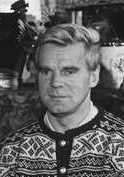Jakob Weidemann

Jakob Weidemann (14 June 1923 - 19 December 2001) was a Norwegian artist. Jakob Weidemann is regarded as one of Norway’s more important artists of post-war Modernism.[1]
Biography
Weidemann was born out of wedlock and spent the first years of childhood with his mother's parents in Steinkjer. His mother married 1930 with life insurance inspector and later art dealer Einar Johansen (1907–82). Weidemann moved to Oslo at age 11 to live with his mother. He was educated at the Bergen Art School (Bergen Kunsthåndverkskole) (1939), Ole B. Eide's art school in Bergen (1940–41) and the Norwegian National Academy of Fine Arts in Oslo (1941). Jacob Weidemann's first exhibition at Blomqvist's Fine Art (Blomqvists kunsthandel) in Oslo during 1946 was his breakthrough.
Weidemann is considered one of the more influential artists within Norwegian modernism in the 1950s. He pioneered abstract painting in Norway in the decades following the Second world war. Weidemanns work Storfuglen letter (1959) was elected as one of the twelve most important Norwegian artworks by Morgenbladet.
Weidemann joined the Norwegian resistance forces during the Occupation of Norway by Nazi Germany, was arrested, but escaped to Sweden. Here he was the victim of an accident in which an explosive charge blew up in such a way that he was blinded. He regained his sight, but then only in the left eye. The experience of being blind may have been decisive for the direction his art was later to take – towards an explosion of color and light.
Abstract, expressionistic paintings with nature as inspiration is characteristic for Weidemann. After some experimentation with different styles in the 1940s and 1950, Weidemann finally settled in what can be called expressive, lyrically abstract art with nature as inspiration and basis. Several of his late works are Inntrykk fra naturen (Impressions from Nature), Interiør (Interior), Veien to Jerusalem (The road to Jerusalem), Storfuglen letter (The great bird lifts off), Tåke i Getsemane (Fog in Getsemane) and Hommage à El Greco.[2]
In 1968, the artist moved with his wife, Anne, to Ringsveen Farm in Lillehammer. Weidemann donated the property to the Ringsveen Trust in 1999 which administers the farm. In keeping with Weidemann’s express wish, it is now a place where young artists can live and work.
Awards
- Anders Jahres Kulturpris (1994)
Notable exhibitions
In addition to regular exhibitions in galleries such as Galerie Ariel (1963–1988) in France, Jakob Weidemann's work was shown in a number of notable exhibition festivals and galleries. During his lifetime, Weidemann's works were shown at Bergen International Festival twice, and was featured at the Venice Biennale in 1967. Kunstnernes Hus displayed his 'Woodland floor' series in 1961.
Present collections
Ringebu Vicarage displays a selection from the collection owned by Lillehammer Kunstmuseum every summer. In addition, a number of museums has parts of Weidemann's work in their collections.
Museet for Samtidskunst in Oslo owns 19 works, among them the two early works ”Interior” and ”Self-portrait” from 1942, and an important work dated to the early 1950s – ”The United Nations”, inspired by the artist Arne Ekeland.
Henie-Onstad Kunstsenter at Høvikodden in Bærum, Norway owns several important works by Weidemann, among others “The Capercaillie flies off”, and the monumental works of the 1960s, “The Road to Jerusalem”, “The Crown of Thorns”, “Fog in Gethsemane” and “Hommage à El Greco”. A typical work dated to his later years – “Blue Rage” – is also at Høvikodden.
The Stenersen Museum in Oslo owns several early and important works by Weidemann, such as “Studio Interior”, “Insane”, “Flag-raising/Liberation”, “Partisan”, “The Seaman’s Widow”, “The Steelworker”, “Petrushka”, and “The Stone Sculpture”. The collection was gifted by Rolf Stenersen’s to the Municipality of Oslo.
The Astrup Fearnley Museum, also in Oslo, owns one important Weidemann; “The Apple-tree and the Rainbow” from 1964.
Weidemann was also commissioned for a number of permanent installations, such as the stained glass in the basilica in Steinkjer, Steinkjer Church (1965), Mai inside the concert hall at Maihaugen in Lillehammer (1967), Alf Bjerckes Fabrikker in Alnabru (1960); Norsk Hydro’s headquarters building in Oslo (1960–1961), Alfaset Chapel in Oslo (1971) and the M/S Royal Viking Sea (1973).
Many of Weidemann's works are also found in private collections around the world.
References
Other sources
- Opdahl, John S. Liss-Jakob Weidemann fra Påssåbyn (eget forlag, 2007) ISBN 978-82-997389-1-0
- Hellandsjø, Karin Jakob Weidemann : storfuglen i norsk kunst (Schibsted, 2003) ISBN 82-516-1982-3
- Koefoed, Holger Portrett i ord : Jakob Weidemann (Labyrinth Press, 1998) ISBN 82-7393-073-4
- Egeland, Erik Jakob Weidemann : portrett av en norsk modernist (Stenersen, 1988) ISBN 82-7201-157-3
External links
- Jacob Weidemanns Mai at Maihaugen
- Weidemann Collection at the Ringebu Vicarage
- Weidemann gallery of art